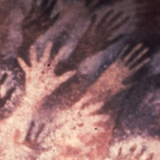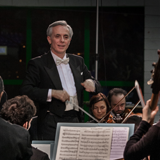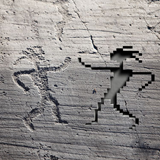
- Presentation
- Program
- Book of abstract
- Events
- Sponsor
The largest archive humankind has on its own remote past is made of images left over the last 50,000 years by the groups of people who spread over the planet reaching all the inhabitable areas of the globe. This is why the Centro Camuno di Studi Preistorici (Camunian Centre for Prehistory Studies) has encouraged since its foundation the meeting and debate among scholars and specialists of different disciplines, contributing to the knowledge and understanding of the rock art phenomenon, particularly through the organization of International Symposia which take place once every two years and which this year will reach their 25th edition.
The 25th Valcamonica Symposium “Art as a source of history” will take place in Capo di Ponte from the 20th to the 26th September 2013, it will be guided by professor Emmanuel Anati, and it confirms the constant role of leadership played by Valcamonica over more than half a century in representing a world meeting point for the studies and research in rock art. The Valley houses the largest rock art concentration in Europe, and derives from this heritage its own identity, pride and its future prospects.
“The search of his own past – professor Anati explains – has engaged man at least since he was considered ‘sapiens’. Man wondered “who am I?” and “where do I come from?”. Such questions defined the Homo sapiens, they turned into sapiens an animal which has in its own way of thinking three time categories: present, past and future. As far as we know, all of the other animals just know two times: the contingent one and the immediate future. Past is recorded in instinct. The third dimension of human thought, the historicization of the antecedent, is shown by art which displays events and pictures cognitive processes.”
The event is sponsored by the most important world institutions engaged in this field: UNESCO (United Nations Educational, Scientific and Cultural Organization), UISPP (Union Internationale des Sciences Préhistoriques et Protohistoriques - International Union of Prehistoric and Protohistoric Sciences) and CIPSH (Conseil International de la Philosophie et des Sciences Humaines - International Council for Philosophy and Humanistic Studies). These sponsorships indicate the prestige of the event and its high international profile. The presence of eminent experts from the five continents confirms the world leading role Valcamonica has in rock art research. The number of recorded participants updated to April 20th is 135, coming from 35 countries of 5 continents.
The final schedule of sessions will be established after the selection of the proposed interventions. As of today, the following sessions are expected:
- Art style, lifestyle
- Art as world heritage (session chaired by UNESCO)
- Making history out of prehistory
- Decoding rock art
- Religions, myths and beliefs through rock art (session chaired by UISPP)
- Images of memory and memory of images
- Ancient and modern graffiti
- Regional identities in rock art
A number of side events will enrich the activities of the 25th Valcamonica Symposium: visits to the rock art parks of Valcamonica, work groups on specific subjects, experts meetings, operative committees and a round table on the Origin of Art.
Program and Calendar of sessions - updated at 01/09/2013. The program can be changed
Read detailed programm | Download detailed programm .pdf
Sept. 20, Friday
| 9:00 - 13:00 | Arrival and registration of participants |
| 17:00 | Opening session |
| 20:00 | Opening dinner |
Sept. 21, Saturday
| 9:00 - 13.00 | Session 1 : Decoding religion myths and beliefs through rock art (Chair Luiz Oosterbeek) |
| 13:00 - 14:30 | Break |
| 14:30 - 19:00 | Session 1 : Decoding religion myths and beliefs through rock art (Chair Luiz Oosterbeek) |
| 20:00 - 22:30 | Round table: What caused the creation of art? |
Sept. 22, Sunday
| 9:00 - 13.00 | Session 2 : Art as world heritage (Chair Nuria Sanz) |
| 13:00 - 14:30 | Break |
| 14:30 - 19:00 | Session 3 : Regional identities and common themes in rock art (Chair Umberto Sansoni) |
| 20:00 | Show |
Sept. 23, Monday
| 9:00-13.00 | Session 4 : Making history of prehistory. Art style and life style (Chair Federico Mailland) |
| 13:00-14:30 | Break |
| 14:30-19:00 | Session 5 : Psychic stories revealed by the arts (Chairs Pierluigi Bolmida and Manuela Tartari) |
| 20:00 | Commission |
Sept. 24, Tuesday
| 9:00 - 17.00 | Visit to rock-art parks of Valcamonica |
| 20:00 | Commission |
Sept. 25, Wednesday
| 9:00 - 13.00 | Session 6 : Decoding rock art: a worldwide survey on methods and theories (Chair Alberto Marretta) |
| 13:00-14:30 | Break |
| 14:30-19:00 | Session 7 : Ancient graffiti and modern graffiti |
Sept. 26, Thursday
| 9:00-13.00 | General debate, recommandation and end of Symposium. Departure of participants |
Session program | Download audio session
Session 1 : Decoding religion myths and beliefs through rock art (Chair Luiz Oosterbeek)
Being cultural means to be capable of living within a systemic network, which implies a certain degree of understanding of basic positional notions: space (where am I?), time (when did something happen?) and, relating both, causality (the cause of something precedes it in time and is spatially related to it). Cultural knowledge of those basic notions is obtained through practising: when the child of a Palaeolithic hunter learned how to prepare an arrow, he was learning the location of different raw materials (space), the effort required to assemble them (time) and the relation of that process with the hunting process as well (causality). But this knowledge had also to be encapsulated in mnemonics and symbols, in order to secure cultural convergence.
This session aims at discussing rock art contexts that may be studied as a means to decode beliefs and the immanent, symbolic or religious understandings of past landscapes. It will bring together experts from different disciplines and will focus on identifying criteria to analyse rock art panels in order to reconstruct the possible underlying basic notions of space, time and causality. (read the book of session 1) (go to the session)
Session 2 : Art as world heritage WARA: World Archives of Rock Art (Chair Nuria Sanz)
Presentation of the achievements of the Rock World Heritage archive, developed in the framework of the HEADS programme.
Over the last two years scholars, technicians, and representatives of the State Parties of the WH Convention met in UNESCO Paris, in Johannesburg, and in Tanum (Sweden) to discuss the scientific and technical aspects of the global archive so as to collectively prepare a prototype of a client server database architecture in order to collect information from the rock art World Heritage sites and from the rock art sites inscribed in the Tentative List. The global application server has been developed (web CMS, image management, document management and a database user interface). The working group discussed the topics of metadata, attributes, access permissions, archeological and environmental information, as well as content related to the state of conservation of the sites. The prototype will be presented in occasion of the 25th International Symposium of Valcamonica, "Art as a Source of History", 20–26 September 2013. (read the book of session 2) (go to the session)
Sessione 3 : Regional identities and common themes in rock art (Chair Umberto Sansoni)
The session is aimed at focusing on the most important and common iconographic themes widespread in European rock art and artefacts of material culture. Our purpose is to encourage to look beyond the borders of one’s own traditional geographic or research context in order to trace the common cultural waves and the centres of diffusion which determined similar iconographic and symbolic frames. Such common patterns constituted the answer to shared problems and developed over several ages towards cases of sameness.
Special attention is paid to the protohistoric developments related to Indo-European images and concepts (3rd-1st millennia BCE) through rock art evidence in the Alpine, Iberian, Scandinavian, Central Asia-Caucasus areas. (read the book of session 3) (go to the session)
Sessione 4 : Making history of prehistory Art style and life style (Chair Federico Mailland)
In a traditional view the demarcation between history and prehistory consists of having available written sources of information on peoples and facts. This session "Making history of prehistory" will focus on how to read and understand the messages left by the ancestors in figurative forms other than writing. This implies to consider prehistoric art as a form of pre-writing.
Forms of art and art styles reflect the lifestyle of peoples not only in prehistory but also in the historical periods. Forms of art depend on the environment, the climate, the availability of resources, the nomadic or sedentary life, as well as the economy: hunting, herding, agriculture. How the style classification in prehistoric art could help us to understand the messages left by the ancestors?
Art styles are commonly used by the archaeologists of prehistory to determine a relative chronology in a common archaeological context. How to reach a universally agreed classification in order to compare different archaeological contexts? (read the book of session 4) (go to the session)
Sessione 5 : Psychic stories revealed by the arts (Chairs Pierluigi Bolmida and Manuela Tartari)
This session is devoted to the “image memory”, studied in its universal aspects of mnemonics, aimed at preservation and transmission of information shared and accessible to all members of the Clan. We will examine the first iconographic representations relating to the Sacred, the first attempts of mourning through iconic transformation, the ability of purely human expression of traumatic experiences using graphic techniques, to reach innovative hypotheses on parallels between writing and identifiable rock art. It also highlights the role played by rock art to promote, engender and stabilize the processes of group cultural identity over time, together with the symbolic, logical process, as a factor of integration and specification of the memory of a group. (read the book of session 5) (go to the session)
Sessione 6 : Decoding rock art: a worldwide survey on methods and theories (Chair Alberto Marretta)
Rock-art is one of the most exciting archaeological sources - but probably also one of the most overlooked - for investigating the cultural framework of prehistoric and tribal populations. Millions of pictures are depicted on open-air rocks, in caves, onto the artifacts found in archaeological sites and constitute a unique insights on society, economy, religion and cosmology. Rock-art has been sometimes regarded as a form of language before writing, a system of communication that involves different actors and a peculiar relationship with the landscape. But the depicted panel constitute also a "coded" document, an assemblage of signs that convey different meaning whether we look at it from inside or from outside the society that produced it. Can we "crack" today these encrypted messages without the help of internal informers? Which is the degree of information about its creators that we are able to deduce from rock-art? How can we deal with the "alien" mind that so often seems to glance at us from the images on the rocks? This session aims at discussing these basic questions from a worldwide perspective and through the analysis of regional cases, innovative methodologies or multidisciplinary approaches. (read the book of session 6) (go to the session)
Sessione 7 : Ancient graffiti and modern graffiti (Chair George Nash)
When looking at prehistoric and historic visual narratives, one can only guess the mindset of the artist and the audience or onlooker. Based on the archaeological and ethnographic records though one can identify that the concept, production and use of rock art involved a complex series of social and symbolic agencies; although the image remains its meaning has been lost. In the recent past, scholars have attempted to draw on the anthropological and ethnographic records in order to make sense of this distant past. Arguably, many of the aspirations, needs and greeds inherent in contemporary society were also probably present during prehistory.
Using the mindset of the modern graffiti artist, this session will discuss the underlying mechanisms that control, influence and manipulate this cultural product, suggesting that some of these mechanisms used in the production of contemporary graffiti were also expressed in prehistoric rock art and its location within the landscape. (read the book of session 7) (go to the session)
Rounde table|Exhibitions|Shows



